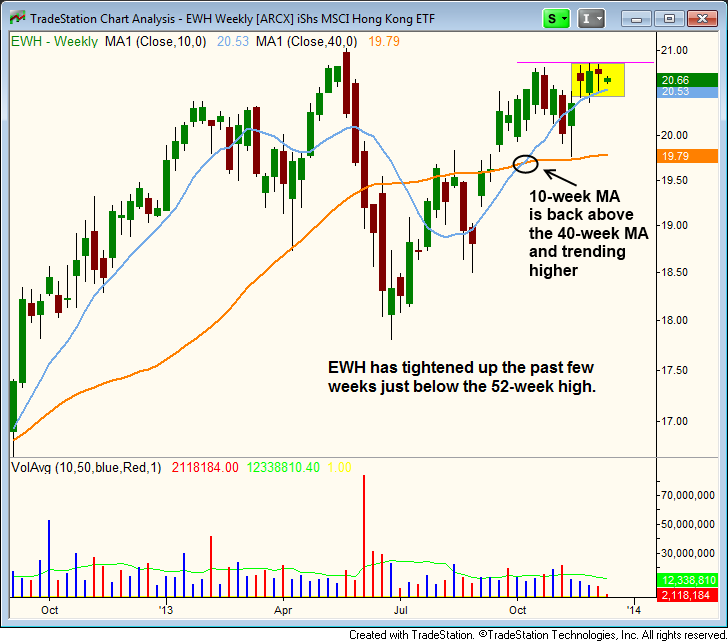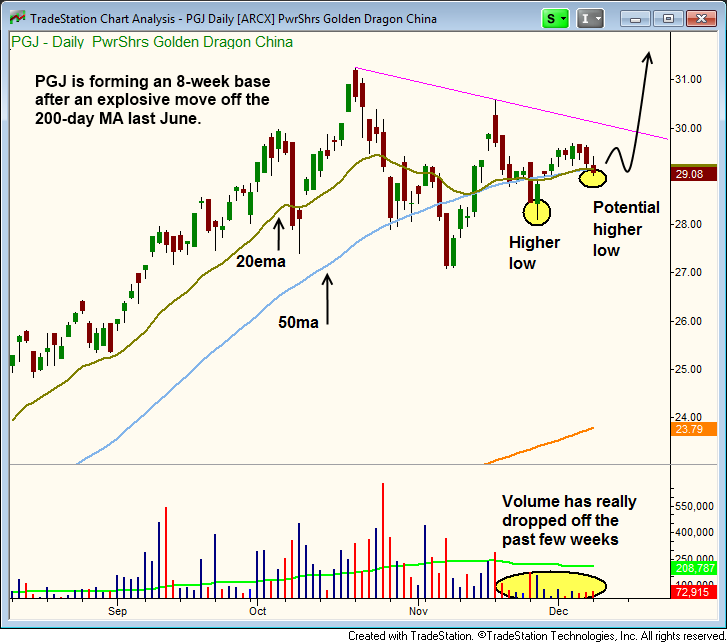| The Wagner Daily ETF Report For December 10 |
| By Deron Wagner |
Published
12/10/2013
|
Stocks
|
Unrated
|
|
|
|
The Wagner Daily ETF Report For December 10
In yesterday's report, we discussed the bullish price action in iShares MSCI South Korea ($EWY). In sticking with the Asian theme, today's report will focus on iShares MSCI Hong Kong Index Fund ($EWH) and PowerShares Golden Dragon China ($PGJ).
After breaking down below the 40-week moving average (orange line below) during the summer, $EWH popped back above the 40-week MA in September.
A few weeks later, the 10-week moving average (teal line) crossed above the 40-week moving average.
This is a known a bullish moving average crossover.
As a sole technical indicator, this moving average crossover does not create a valid buy entry, but it shows that bullish price momentum is building in the right direction:

In addition to the 10-week moving average crossing above the 40-week moving average, notice that $EWH has also formed a very tight range above its rising 10-week moving average (yellow rectangle).
If the price of $EWH can continue to trade in a tight range, we should soon see a breakout to a fresh 52-week high.
Nevertheless, the price action needs to stay pretty tight because we do not want to see another test of the 40-week moving average (just below $20).
After an explosive run throughout this past summer, $PGJ eventually ran out of gas and stalled out just above the $30 area.
However, it has since been forming a bullish and constructive base of consolidation (learn about the importance of basing action here).
On the daily chart below, notice that $PGJ has mostly been holding above intermediate-term support of its 50-day moving average.
There were a few minor "undercuts" below that key moving average, but such price action is to be expected when a stock/ETF is basing out:

$PGJ has already established a "higher low" within its base, and a second higher low could be in place by the end of the week.
While forming a base of consolidation, these higher lows and lower highs lead to a tightening of the price action (from the left side of base to the right), which is exactly what we want to see.
Overall, basing action is a pretty simple concept.
Volatility expands when the price begins to decline from the highs, then eventually contracts when a bottom starts to form (higher lows within the base).
After a few weeks of contracting volatility on lighter volume, volatility once again picks up when the stock/ETF eventually breaks out again and resumes its dominant uptrend.
Deron Wagner is the Founder and Head Trader of both Morpheus Capital LP, a U.S. hedge fund, and MorpheusTrading.com, a trader education firm.
|